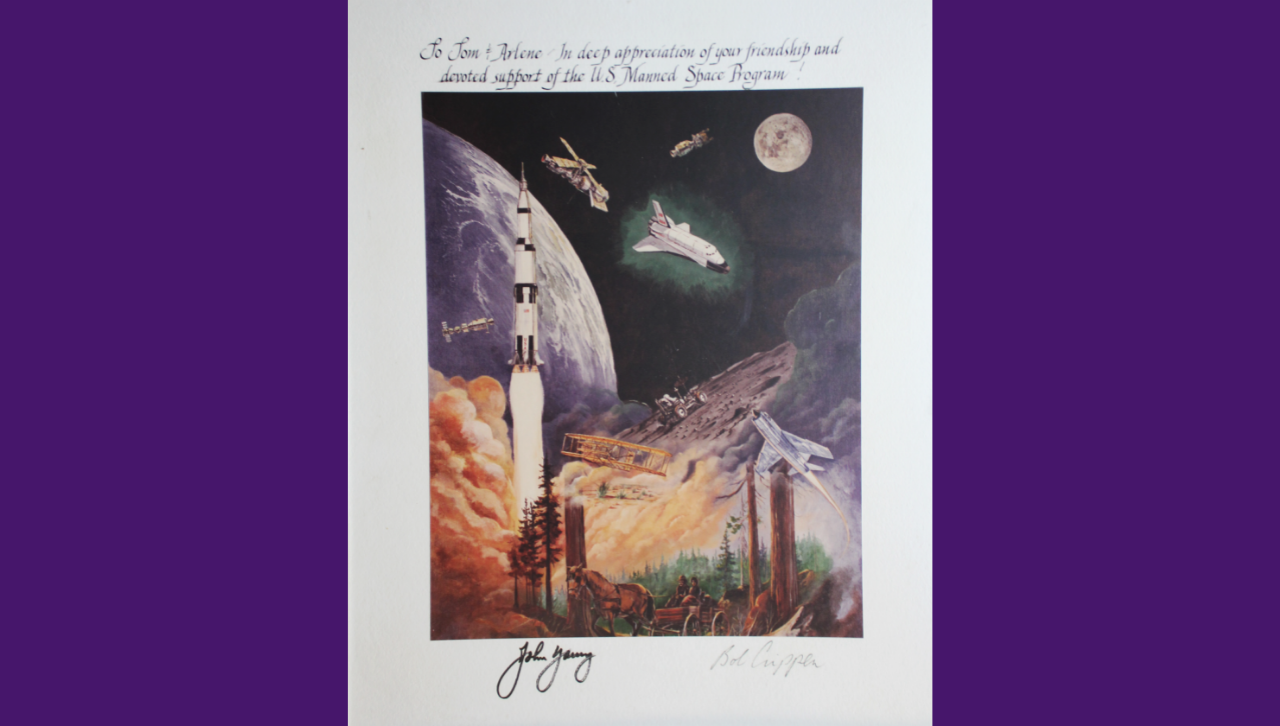University To Present 'New Frontiers: The Thomas N. Tate, Esq. '56 Collection' Oct. 14

The University of Scranton will present “New Frontiers: The Thomas N. Tate, Esq. ’56 Collection of Aerospace Memorabilia” at 5 p.m. Oct. 14 on the first floor of Hyland Hall in the Department of Physics and Engineering Mechanical Engineering Facility.
A native of Olyphant, Tate received his B.S. in Marketing from the University in 1956. From 1962 through 2003, he played a major role in the national aerospace program, working for government and industry on the Gemini, Apollo and Space Shuttle initiatives. In a career spanning more than four decades, he held positions with a private corporation, working at Rockwell International for 12 years; the federal government, serving on the House of Representatives’ Committee on Science and Technology for 15 years; and an advocacy group, working for the Aerospace Industries Association for 17 years.
Tate will also appear as a guest speaker at The Institute for Electronics and Electrical Engineering Seminar Series Oct. 14 at noon in Hyland Hall’s Room 102. In conjunction with this presentation, the “Tate Collection of Aerospace Memorabilia,” which Tate recently donated to the University, will have a permanent home in the department’s new Mechanical Engineering facility in Hyland Hall.
The Mechanical Engineering Program in the Physics and Engineering Department is a 5,300 square-foot, state-of-the-art learning and laboratory space. Using modern equipment and contemporary methods, students learn analysis, synthesis and evaluation for understanding solid mechanics, fluid mechanics, dynamics and thermodynamics, control, and vibration. They work with a wind tunnel, where they determine fluid characteristics by measuring aerodynamic pressures, forces and moments applied to aerodynamic models by the airflow in laminar and turbulent flows. They also investigate the behavior of engineering materials by performing tensile and compression tests to determine material properties such as strength, modulus of elasticity, yield, and failure stresses.
The exhibition of the “Tate Collection of Aerospace Memorabilia” will not only document an important phase of engineering history, but it will also convey to students the exciting careers and endless possibilities that a University of Scranton education provides.
Through the NASA memorabilia collection and his personal recollections of his time in the aerospace industry, Tate takes us on a spectacular journey through an age of discovery best exemplified by the moon landing. His pioneering spirit helped forge a new era of space exploration that future generations will continue to study for ages to come.
Tate was part of the space journey from the very beginning, when President Kennedy committed the nation to “landing a person on the moon before the end of the decade.” Tate’s Jesuit education at Scranton convinced him to listen to his calling and “go forth and set the world on fire.” He set out for California with his marketing degree from Scranton, and his confidence landed him a position testing, analyzing and synthesizing data for the NASA and Rockwell flight teams. His early work with spacecraft testing for Rockwell International at Edwards Air Force Base set the stage for his next two career paths: serving the House Committee on Science and Technology, and serving as Vice President of the Aerospace Industries Association.
While the early NASA work was exciting and generously funded, shuttle setbacks and economic downturns ultimately grounded plans for continued spaceflight. Still, the aerospace program left a remarkable legacy, opening a universe of possibilities for those who care to enter. It continues to inspire innovation, exploration and discovery in children and adults worldwide. Some of its benefits range from current students’ interest in space education to the expanded role of private industry in aerospace activities and plans for visiting Mars. While the inventions that resulted from the program are too numerous to mention, their enormous impact on our civilization helps us study, save and preserve our planet for future generations.
Tate’s legacy with our space program is a powerful reminder of where a University of Scranton degree can take you. Tate traveled the world after graduation, and his love for The University of Scranton remained front and center in his life because of Scranton’s outstanding professors and the Jesuits who encouraged his curiosity and the Socratic method of learning.
“My Jesuit education provided character building and self-discipline with rigorous leadership training from the military sciences,” he said. “The Jesuits taught me and continue to teach current students to look beyond what is in front of them. Throughout my life, I stayed connected to Scranton and The Alumni Society. Because of great professors and the Jesuit influence on my life, I established, endowed and continue to support The Tate Family Scholarship. I’ve also chosen membership in The Estate Society.
“I know that with philanthropy comes promise and possibilities. I want the next generation of explorers to receive a Catholic and Jesuit education that takes them to discovering their great frontier. Together, our support can redirect their future in ways unimagined. I firmly believe in the scripture, ‘To whom much is given, much is expected,’ and I am honored to support my alma mater’s mission.”






